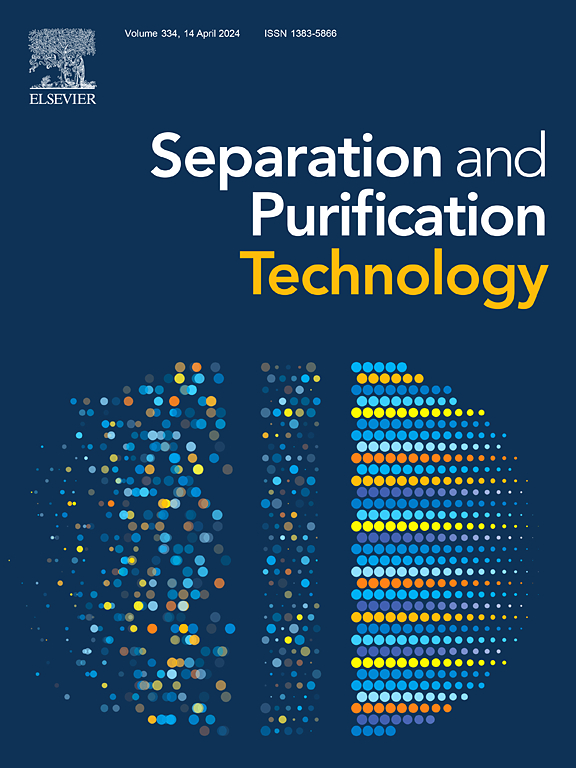利用纳米钛-锌二元金属氧化物提高高盐废水中焦磷酸铜络合物的去除率:多元络合机制
IF 8.1
1区 工程技术
Q1 ENGINEERING, CHEMICAL
引用次数: 0
摘要
镀铜废水中存在的盐离子(通常为 1000 mg/L)限制了离子交换法在铜络合物(如焦磷酸铜 (Cu-PPi))深度处理中的应用。金属纳米粒子固定化是一种有效的方法,双金属纳米粒子比单金属纳米粒子更有潜力。本研究通过将氧化钛-氧化锆纳米粒子限制在阴离子交换聚合物(D201)的孔隙中,成功合成了双金属纳米复合材料 Ti-Zr-201。与单金属纳米复合吸附剂(Zr-201 和 Ti-201)相比,双金属掺杂结构的新型吸附剂 Ti-Zr-201 具有更多的活性位点(7.22 mmol/g)、更高的羟基含量(3.51 × 1022 OH/ nm2)和更大的比表面积(31.65 m2/g)。结果表明,在高盐水(2000 毫克/升 NO3-)中,Ti-Zr-201 比 Zr-201(21.48 毫克 Cu/g)和 Ti-201(21.71 毫克 Cu/g)具有更好的 Cu-PPi 吸附能力(24.82 毫克 Cu/g)。进一步的机理研究表明,Cu-PPi 的整体去除主要是通过吸附过程中形成的三元络合(A 型 Ti/Zr-O-Cu-PPi、B 型 Ti/Zr-O-PPi-Cu)和四元络合(B 型 Ti/Zr-O-PPi-Cu-PPi)来实现的。饱和的 Ti-Zr-201 可以快速再生 90% 以上,并且具有良好的稳定性。此外,这种新型吸附剂对其他几种磷铜络合物(三聚磷酸钠、磷酸二氢甲酯等)也有很好的去除效果。因此,纳米复合材料 Ti-Zr-201 在深度去除高盐废水中的磷配体络合态铜方面具有广阔的应用前景。本文章由计算机程序翻译,如有差异,请以英文原文为准。

Enhanced copper pyrophosphate complex removal from high salty wastewater by using nanoconfined Ti-Zr binary metallic oxides: Multivariate complexation mechanism
The salt ions (typically > 1000 mg/L) present in copper plating wastewater limit the application of ion exchange in the deep treatment of copper complexes (such as copper-pyrophosphate (Cu-PPi)). Metal nanoparticle immobilization is an effective method, and bimetallic nanoparticles have more potential than monometallic ones. In this study, bimetallic nanocomposite Ti-Zr-201 was successfully synthesized by confining Ti-Zr oxide nanoparticles in the pores of anion exchange polymer (D201). The obtained new adsorbent Ti-Zr-201 with bimetallic doped structure had more active sites (7.22 mmol/g), higher hydroxyl content (3.51 × 1022 OH/ nm2) and larger specific surface area (31.65 m2/g) than monometallic nanocomposite adsorbents (Zr-201 and Ti-201). The results showed that Ti-Zr-201 has better Cu-PPi adsorption capacity (24.82 mg Cu/g) than Zr-201 (21.48 mg Cu/g) and Ti-201 (21.71 mg Cu/g) in the high salt water (2000 mg/L NO3–). Further mechanistic studies revealed that Cu-PPi removal as a whole was mainly realized via ternary complexation (Ti/Zr-O-Cu-PPi of Type-A, Ti/Zr-O-PPi-Cu of Type-B) and quaternary complexation (Ti/Zr-O-PPi-Cu-PPi of Type-B) both formed during the adsorption. The saturated Ti-Zr-201 can be regenerated more than 90% rapidly and had good stability. Moreover, the novel adsorbent also had a excellent removal effect on several other phosphorous copper complexes (tripolyphosphate, methyl dihydrogen phosphate, etc.). Therefore, the nanocomposite Ti-Zr-201 exhibited promising application on the deep removal of complex-state Cu with phosphorus ligands from high salty wastewater.
求助全文
通过发布文献求助,成功后即可免费获取论文全文。
去求助
来源期刊

Separation and Purification Technology
工程技术-工程:化工
CiteScore
14.00
自引率
12.80%
发文量
2347
审稿时长
43 days
期刊介绍:
Separation and Purification Technology is a premier journal committed to sharing innovative methods for separation and purification in chemical and environmental engineering, encompassing both homogeneous solutions and heterogeneous mixtures. Our scope includes the separation and/or purification of liquids, vapors, and gases, as well as carbon capture and separation techniques. However, it's important to note that methods solely intended for analytical purposes are not within the scope of the journal. Additionally, disciplines such as soil science, polymer science, and metallurgy fall outside the purview of Separation and Purification Technology. Join us in advancing the field of separation and purification methods for sustainable solutions in chemical and environmental engineering.
 求助内容:
求助内容: 应助结果提醒方式:
应助结果提醒方式:


